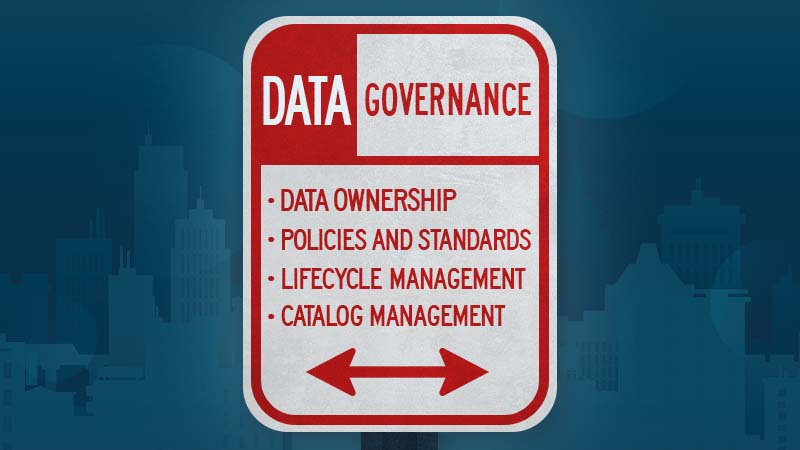Table of Contents
Contents
- Base Your MDM Strategy Around a Clearly Defined Business Problem
- How Starting with a Problem Helps Create a Program Map for Your MDM Strategy
- How Starting with a Problem Helps Secure Buy-In
- Determine How You Will Measure Success From the Start
- What Happens Next? 5 Traps to Avoid in Getting Started with Your MDM Strategy
- Start Off on the Right Track with Your MDM Strategy
X
In this three-part blog series, we dive into each component of the Definitive Guide to MDM Strategy. See the individual parts below:
6 key pillars for a successful MDM implementation:
As organizations continue to produce and collect enormous amounts of data, properly managing that data becomes increasingly critical. That’s because proper data management helps maintain cleanliness and accuracy in order to avoid costly errors and makes it possible to glean insights from data to drive new efforts that will add value back to the business.
Against this backdrop, more and more organizations are introducing Master Data Management (MDM). However, only those that approach their MDM strategy correctly will end up realizing the full payoff they set out to achieve. So what’s the right approach to MDM?
To answer this question, let’s go to the very beginning by taking a look at the best way to get started with your MDM strategy.
Base Your MDM Strategy Around a Clearly Defined Business Problem
MDM is often an IT-led initiative, and one of the challenges IT teams getting started with MDM tend to face is that without a good strategy, it’s hard to get business stakeholders on board. The key to overcoming this challenge is to base your program around a clearly defined business problem. To identify and define the problem you’re trying to solve, you need to pinpoint critical business needs that aren’t being met and determine the underlying problem as to why that’s the case. From there, you should find it far easier to decide on the direction in which you want to take your MDM program to resolve that problem. You should also find it easier to get buy-in for those initiatives.How Starting with a Problem Helps Create a Program Map for Your MDM Strategy
Far too often, organizations focus on their goal for MDM and think that’s going to solve a problem, but they haven’t actually figured out what the problem is, and that complicates things. Consider the case of an organization that has a problem increasing sales, particularly when it comes to cross-selling existing customers on other lines of business. On the one hand, that organization can say: “Our problem is MDM. We need more MDM.” But where is that going to take them? It doesn’t provide any direction about what’s actually needed. That’s because a lack of MDM is not the problem. Rather, the problem is that the sales team can’t see what the entire organization looks like and they need to have that visibility in order to improve cross-sell capabilities. With that in mind, the solution might be improving visibility into customer data across the organization through MDM so that the sales team can understand how what the organization sold to Company A would be valuable to other companies that have a similar profile. Or think about solving the problem of compliance. With the new GDPR regulations, financial companies are trying to maintain complete visibility into their data to ensure they’re using customer accounts in the right way at the right time. For them, the problem is understanding what data is associated with an entity or person and maintaining control over that data so it’s clear what users can do with it and when they can use it. Essentially, it’s all about answering the five W’s for customer data across the organization: The who, what, when, where and why. Once again, MDM is the solution — a lack of it is not the problem. In this case, the MDM solution is about consolidating customer data into a single location so that users can leverage it across all of their systems and don’t have to make very expensive calls to outside services over and over again. Whatever your exact situation may be, as you get started with your MDM strategy, it’s important never to lose sight of that fact that you’re solving a business problem. And if you can do that, you should have a much clearer roadmap as to how you can use a MDM solution to solve that problem.How Starting with a Problem Helps Secure Buy-In
Starting with a problem is all well and good, but how do you use that to get buy-in for your MDM program? It’s a challenge that many organizations face, and one of the primary reasons for this struggle goes back to the fact that organizations often start with the “how” instead of the “why.” For example, what happens if you say: “We need funding to solve a business problem around Customer 360.” The reality is that Customer 360 (aka better data) is actually the “how” — what you need to get in order to solve a problem — not the “why,” or the problem itself. In cases like these where organizations take on Customer 360 for the sake of Customer 360, the MDM program often ends up a wasted effort. Because if your goal is to introduce Customer 360, you’re not only going to struggle with initial buy-in, but you’re also going to struggle with ongoing support, adoption and everything that follows, since business users in marketing and sales could care less about Customer 360. In fact, they likely don’t even know what that is. Additionally, starting with a clearly defined business problem helps guarantee that someone in your organization has an actual use for the data in question. That guarantee is important because if you plan to implement something like Customer 360 as part of your MDM program and spend a significant amount of time managing customer data but your business users aren’t going to leverage it, then initial buy-in will be an uphill battle. And even if you do get buy-in, you likely won’t see any ROI at the end of the project. In contrast, knowing you have a specific problem or problems you need to solve for and implementing MDM as a solution is a completely different story. If you say, “we need to better know who our customers are and what their buying habits are so we can cross-sell them more effectively” or “we need to ensure GDPR compliance,” that gives you a focused scope that the business can get behind.Determine How You Will Measure Success From the Start
Once you clearly define the business problem you’re trying to solve (and map out next steps and get buy-in for those initiatives), you then need to determine how you will measure success. It’s critical to outline success measures upfront as a part of your strategy rather than waiting until the end of the project to figure out how you can prove that the program you just spent significant resources on is indeed valuable. Putting in the effort upfront to determine how you will measure the success of your program is so important because you can then keep those measures in mind as you implement your MDM solution. By doing so, you can make sure that a few months down the line you will actually be able to demonstrate the success you wanted to see. Fortunately, if you define the problem you need to solve well, you should have a clear vision of what outcomes you need to measure to determine success and quantify your return on investment. For instance, if you say you want to better cross-sell to your customers, you can then go back and see how well you did on that front after improving access to customer information across the organization. Or let’s say your problem is a mailing situation in which you’ve had 30% return mails for your catalogs every month. Six months after undergoing a MDM project, if you can go back and say, “Now our return mails are down to 10%. Look at how much money we’ve saved,” that’s a big deal. In turn, these success metrics should make it much easier to sell the value of MDM back to management and explain how the project has helped the business. If you go back and just say: “We implemented Customer 360 and now we have more data on our customers,” it’s very hard to tie that back to success. But if you can say: “We implemented Customer 360 to get more data on our customers in order to solve the cross-sell problem and we’ve increased revenue from existing customers by 20% since then,” that’s an entirely different story.What Happens Next? 5 Traps to Avoid in Getting Started with Your MDM Strategy
After clearly defining your business problem and identifying how you will measure success, it’s time to put your MDM strategy into action. As you do so, be careful to avoid these five traps that often creep up along the way.1) Boiling the Ocean
Far too many organizations fall into the trap of trying to boil the ocean with MDM. But the organizations that have the most success with MDM are those that break it up into smaller pieces rather than tackling MDM as one monolithic project. For example, if you try to do a $3 million MDM engagement, that means you need to get practically your entire organization on the same page and get buy-in from everyone at once. Now that is extremely challenging to do. However, if you set out to solve a small data management problem around customer data, you’ll find that bringing MDM to the rest of your organization becomes much easier. That’s because once you solve the first problem and deliver an incredible ROI (which you can likely do over the course of several months, not years), when the next problem that you want to bring into the MDM solution crops up, it’s much easier to sell that group on MDM by saying: “See what we’ve done here? We can do the same for your group.” Overall, once you get buy-in initially, it becomes much easier to add to your MDM solution as you move across the organization. Furthermore, you get better success metrics by taking on smaller projects versus boiling the ocean because it’s very hard to measure progress after you finish an expansive two to three year engagement.2) Pigeon-Holing MDM to IT
Another trap to avoid is thinking of MDM as a technology platform that IT owns. Quite the contrary, MDM is very much an investment that the business is making. The best way to avoid this trap is to think of MDM like the infrastructure and plumbing inside a building. Nobody looks for the sexiest plumbing system, but it is critically important to the building. And even though no one notices when it’s working correctly, everyone notices — and has a big problem — if it stops working. Similarly, if you don’t have a business-focused data management strategy and you don’t have a process for managing your data that involves business stakeholders, then you’re going to end up with chaos, just like you would if you didn’t have internal plumbing.3) Branding MDM as a “Single Version of the Truth”
Next, it’s essential to be careful how you talk about the data managed through your MDM program. If you approach your business problem as “finding a single version of the truth,” that implies ownership for one specific group because it means there is only one way to look at customers and only one way to look at products. When you do that, you set yourself up for failure, because if you choose a way to look at data that is designed for the initial buyers of the MDM program, whether that’s sales, marketing, management or anyone else, then you may find that there are a lot of other groups that you leave out of what that final version of the truth is. In doing so, you limit how far you can extend the reach of MDM within your organization. Additionally, if you take a “single version of the truth” and use that to determine your ROI down the road, you’ll find failures anywhere in the organization that relies on another truth for customer or product data. That makes it very easy to discount any success you do see, as someone can easily step in and say you didn’t solve their problem because they need to view customer and/or product data differently. Instead of taking that “single version of the truth” approach, what you really want to do is search for a “better truth” for your organization. That’s a much more open and honest way to handle the process because it allows for there to be numerous ways that different groups can view customers and products. You can then fold those viewpoints into your “better truth” as you move data through the organization.4) Eliminating All Duplicate Data
While it’s true that duplicate data can cause serious problems for organizations, it’s important to remember that there are some cases where duplicate data is necessary. And just because you have specific data quality problems or integration challenges that you want to solve doesn’t mean you have to eliminate that duplicity. For instance, you might need to have the same customer listed three times because there are actually three different divisions in the organization that sell to the same customer and each needs its own record. In these cases, you need to be able to the manage duplicate data properly and ensure you have those duplicates for a legitimate purpose. We can call this “duplication by design.” Duplication by design is something that most organizations can’t do easily, but a proper MDM strategy does make it possible. Achieving duplication by design is all about elevating the duplicates that need to exist and making the business reason for that duplicity transparent. Ultimately, providing that visibility, including the ability to see each different representation of a customer’s name and know which systems those values came from, can make users’ lives significantly easier.5) Doing MDM for the Sake of MDM
Finally, organizations that do MDM for the sake of MDM have a big problem ahead of them. If you take your organization down an expansive MDM journey but you’re doing MDM just for the sake of it because you know it’s the right thing to do, it’s not going to work out the way you want. This trap goes back to the need to clearly define the business problem you’re trying to solve with MDM. Because when you do MDM for the sake of MDM, you end up with a massive, boil the ocean-type project and no clear vision for how to execute or measure success. And that makes it very difficult to get everyone to agree on the direction up front, which makes securing the proper buy-in and funding challenging. Furthermore, the payback, or the time frame between when you start the project and when you start seeing the benefits of it, becomes extremely long. As a result, these projects often become at risk, because organizations simply can’t justify the time and money spent.Start Off on the Right Track with Your MDM Strategy
Introducing a MDM program can prove extremely valuable for your organization, but simply implementing a MDM solution will not deliver that value automatically. To realize a high return on investment and solve critical business problems, you need to take a strategic approach to your MDM program. With that in mind, as you map out your MDM strategy, remember to start by clearly defining your business problem and determining how you will measure success from the start. Doing so will set you up for maximum success by making it easier to determine a roadmap for your MDM program and by helping secure buy-in and funding.
Eric Melcher
Eric has spent the entirety of his 15+ year career working in the enterprise information management space. As Chief Technology Officer, Eric is responsible for all aspects of product management, development and support for Profisee’s software portfolio.











